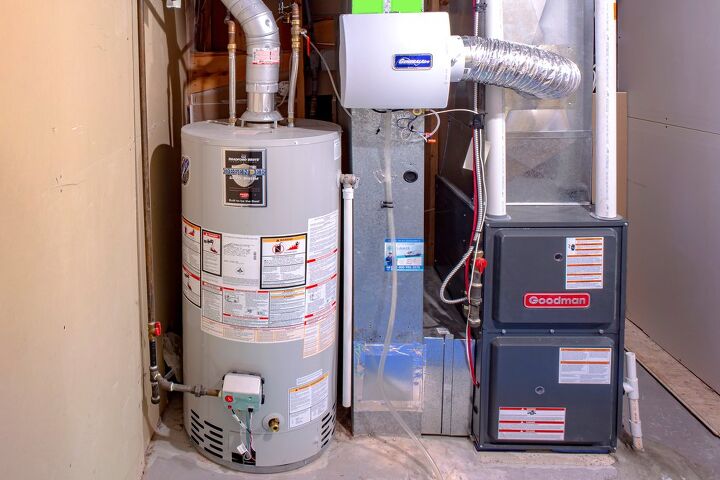Water Heater Dimensions (with Drawings)

The majority of homeowners don’t prefer cold showers and high energy costs. A good water heater can provide your home with reliable hot water that is also cost-effective. Before purchasing a water heater, ensure that you have determined the correct size you need for your home.
The household size will determine the best water heater size. A 23 to 36-gallon tank water heater can serve a house that has two or fewer people. A 36 to 46-gallon tank is for homes of four people; any more requires 46 to 56-gallon tanks.
Water Heater Fuel Sources
Water heaters have different fuel sources that power the heater. The fuel source can be electric, gas or propane, or a hybrid fuel type.
Gas Water Heater
Gas water heaters use a burner to heat water. They range in size from 30 to 100 gallons.
Electric Water Heater
Electric water heaters use one or two replaceable heating elements that heat water. They range in size from 28 to over 100 gallons.
Heat Pump Water Heater
A heat pump water heater uses energy from the air to heat water. They can be stand-alone water tanks or built into existing tanks. They range in size from 50 to 80 gallons.
Types of Hot Water Heaters
Before purchasing a water heater, consider your family’s size and the utilities available in your area.
Storage Tank Water Heater
A storage-tank water heater is the most common type of water heater. They are available in electric, liquid propane, and gas models. Natural gas and propane water heaters usually use less energy and are less expensive to operate than electric models.
Tankless Water Heater
Tankless water heaters don’t store hot water. Instead, they heat the water as it passes through coils in the unit.
Because they only heat the water being used, they’re more energy-efficient than traditional storage-tank water heaters. Tankless water heaters are available in electric, liquid propane, and natural gas models.
Most tankless water heaters provide up to 3.5 gallons of heated water per minute. It’s best for someone whose demand doesn’t require hot water in more than two places at a time.
If you have a larger family, the Rheem Professional Prestige Gas Water Heater is a good option. It provides 9.5 gallons of heated water per minute. It has a height of 27. 5 inches, a width of 18.5 inches, and depth of 9.75 inches.
An electric tankless water heater option is the Rheem Performance Tankless Electric Water Heater. It provides 8.8 gallons per minute of heated water. It has a height of 18.25 inches, a length of 21.625 inches, and a depth of 3.5 inches.
Utility Water Heaters
Utility water heaters are also known as point of use (POU) water heaters. They are a good choice for shops or garages. They range in size from 2.5 to 20 gallons and can sometimes be used to provide hot water to a secondary bathroom.
The largest POU heater is good to have if you have bathrooms that aren’t near your main water heater. The Rheem Marathon POU Electric Water Heater has a 20-gallon capacity. It has a height of 30.5 inches and a diameter of 23.5 inches.
Water Heater Tank Capacity
Storage tank water heaters are classified by the amount of water they hold in gallons. To ensure that your household has enough hot water, you need to determine the water used on average. Smaller households can have smaller tanks, while larger households require larger tanks.
Also, consider the storage tank water heater’s recovery rate. The recovery rate is the number of gallons of water it can heat in an hour while refilling the tank. If you have a higher demand for hot water, you’ll need a higher recovery rate.
Follow the recommendations as a guide to find the size water heater you need.
Electric Water Heater Tank Capacity
You will need an electric water heater tank capacity of 30 gallons for a one to two-person household. A water heater of this size usually has a height of 49.5 inches and a diameter of 21.63 inches. This heater weighs about 75 pounds.
For a two to three-person household, you need an electric water heater tank capacity of 40 gallons. A 40-gallon water heater is typically 61.25 inches tall by 18 inches wide and can weigh 115 pounds.
A family of three to four people requires a 50-gallon capacity electric water heater. A Rheem Marathon Electric Water Heater is a good option for a household of this size. It has a height of 47.25 inches and a width of 28.25 inches.
For households with five people or more, you need an electric water heater with a capacity of at least 80 gallons. The Rheem Marathon Electric Water Heater comes in an 85-gallon tank, ideal for a big family. It has an overall height of 70.25 inches, a diameter of 28.25 inches, and weighs about 134 pounds.
Gas Water Heater Tank Capacity
Gas water heaters do not need as large of a tank capacity to heat households as electric water heaters do.
For a one to two-person household, you need a gas water heater with a capacity of 30 gallons. The Rheem Performance Atmospheric Gas Water Heater has an overall height of 46.35 inches and a diameter of 19.75 inches. This water heater weighs 112 pounds.
Households with two to four people require a gas water heater that has a capacity of at least 40 gallons. The Rheem Performance 40 gallon gas water heater has a height of 58.5 inches and a width of 19 inches.
For households of five or more, you need a gas water heater with a 50-gallon tank. The Rheem Performance Platinum Gas Water Heater has a height of 50.5 inches and a width of 23.75 inches.
Space for A Water Heater
Your storage tank water heater could be in the attic, in an outdoor shed, or inside a closet. Before purchasing a new one, you should measure the height of the space where your water heater will go. Using a tape measure, measure from the floor to the ceiling and then measure the area’s width.
The major differences in water heaters are height, gallon capacity, and required height for plumbing connections. Water heaters come in short varieties and tall varieties.
Short Water Heaters
Short water heaters are shorter and wider than a typical water heater, but they hold the same amount of water. The benefit of short water heaters is that they can fit into areas limited in headroom like crawlspaces. Short water heaters, or lowboys, vary from 30 to 49 inches tall and hold up to 50 gallons of water.
Tall Water Heaters
Tall water heaters are ideal for basements or garages where height isn’t an issue. If you have a hybrid water heater, it may require extra space to function. Tall water heaters range from 50 to 76 inches tall and can hold up to 100 gallons of water.
Water Heater First Hour Ratings
In addition to tank capacity, also consider the water heater’s first-hour rating. First-hour rating (FHR) describes how much hot water a tank can produce in an hour when it’s fully heated. FHR determines the water heater’s efficiency and gives an idea of what the heater can handle at peak usage.
Your water heater’s FHR should meet or exceed the number of gallons of hot water needed for each activity performed simultaneously.
To determine your ideal FHR, use the numbers below.
- Bathing or showering requires 20 gallons of hot water per person.
- Washing your hair requires 6 gallons of hot water per person.
- You need 2 gallons of hot water per person for hand washing.
- Washing dishes by hand requires 6 gallons of hot water per person.
- Shaving requires 3 gallons of hot water per person.
- Running the dishwasher requires 14 gallons of hot water.
- Running the washing machine requires 30 gallons of hot water.
Necessary Clearance for Water Heaters
The necessary clearance needed for a water heater will depend on whether the heater is gas or electric. If you have a gas water heater, 24 inches of clearance in the front is ideal. There should also be two inches in the back and two inches on each side of the heater.
Electric water heaters do not require a minimum clearance. However, most electrical equipment codes require a 30-inch working space on the front and sides of the heater. This allows for examination, adjustments, or maintenance of the electric water heater.
The National Electrical Code also recommends a 3-foot clearance in front of electrical equipment. The code recommends a minimum headroom of 6 feet, as well.
Related Questions
Do mobile homes require specific types of water heaters?
Mobile homes do require a specific kind of water heater that can be gas or electric. If you choose to have a gas water heater in your mobile home, be sure to purchase the appropriate connection. The connection type will be propane or natural gas. When purchasing a water heater for a mobile home, consider the location. If you purchase a gas water heater that you will enclose, you need a sealed combustion gas water heater. If there’s outside access, a standard gas water heater will work. Check for accurate measurements before purchasing as mobile home door openings can be smaller than average homes.
Can I install my water heater in a closet?
If your house lacks a basement or garage, it may be necessary to install the water heater inside of the house. People often install water heaters in closets where they won’t be visible. Before installing, replacing, or repairing the water heater, you’ll need a permit to determine whether or not it’s safe. Water heaters require a certain amount of clearance to function properly. There needs to be a clearance area of 12 inches on all sides of the water heater. You also need a certain amount of airflow for proper ventilation. Building code states that there must be one air opening within 12 inches of the water heater’s upper enclosure. You must install another air opening within 12 inches of the water heater’s lower enclosure. Air ducts required for combustion must be at least 3 inches in diameter.

Stacy Randall is a wife, mother, and freelance writer from NOLA that has always had a love for DIY projects, home organization, and making spaces beautiful. Together with her husband, she has been spending the last several years lovingly renovating her grandparent's former home, making it their own and learning a lot about life along the way.
More by Stacy Randall

































